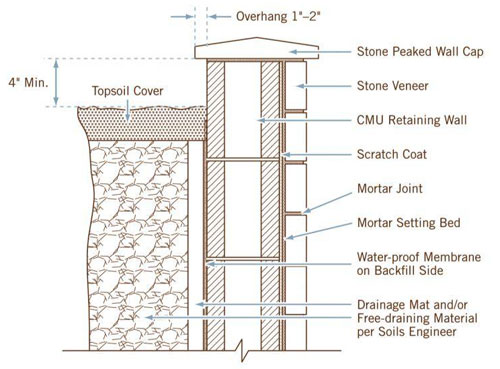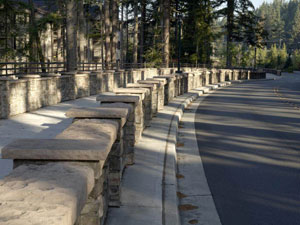Architectural Stone Veneers: Authentic and Appropriate Technology
Common Wall Substrates
Manufactured stone veneer can be applied to most common wall substrates – concrete masonry units (CMU), poured-in-place concrete walls, metal studs, metal panels, wood sheathing, open stud framing as well as rigid insulation. This section illustrates the appropriate application of stone veneer onto prepared scratch coat surfaces. The wall diagrams are to be used as reference only as all substrate construction should be designed to meet prevailing local building codes. The following is a brief review of some of the technical requirements for each substrate material and wall system.
Concrete
Stone veneer can be applied to clean, unpainted CMU block surfaces. It can also be applied over horizontally scored scratch coat. The installer should ensure a clean surface by spraying water on the block to see if the water beads. If so, additional treatment such as sandblasting or powerwashing, may be required for installation. If the CMU cannot be cleaned properly, metal lath may need to be installed using concrete nails or screws and a scratch coat applied to the lath before placing the veneer. The stone veneer is hand placed in a mortar setting bed by the installer.
A common use of stone veneer is to add it to the face of a retaining wall above the ground plane. Below-grade installations can lead to efflorescence, spalling and discoloration from minerals in the soil. For installations at grade, sealing the stone will minimize the potential for stains. Retaining walls should be designed and engineered for the environment. Dependent on the climate, the design professional will specify the proper mortar and cement mixtures to resist freeze and thaw constraints. Common practices for detailing retaining walls include the protection of surface water into the system by wall caps that extend beyond the wall edges from 1 in. to 2 in. minimum. This applies to any retaining wall with a stone veneer surface as well. Typically, the side of the wall that faces the earth is coated with a bitumen surface, and soil engineers will specify drainage materials, piping and/or a drainage mat to reduce the pressure on the wall from moisture accumulation.
 |
Image courtesy of Eldorado Stone Typical retaining wall detail. |
The design of the wall system should also include the planning for the irrigation system that may be designed later by the landscape architect or engineer. Stone veneer should never be used below water level. Landscape architects should consider using drip water systems around stone surfaces and avoid any prolonged irrigation spray of water. All irrigation water should be directed away from stone surfaces.
 |
Photo courtesy of Eldorado Stone Architectural stone veneer can be used in parks, along roadsides and as part of a nature trail. |
To prepare the surface of a concrete poured-in-place wall, the installer will sand blast or powerwash the wall until it has a sandpaper-like texture. Applying a metal lath provides the most trouble-free installation on poured-in-place walls but using a primer (dash-bond coat) may increase bonding for applications without metal lath. When installing a metal lath, the designer should specify a maximum of 6-in. x 16-in. spacing between fasteners.
Many big-box stores use stone veneer surfaces over poured-in-place walls. The veneer usually is assembled and manufactured on panels rather than hand placed on the site for this application.
Some commercial properties are combining manufactured stone veneer with a stucco finish. There are two important requirements to be met when using stone veneer with stucco. Stone veneer can be installed over clean stucco surfaces that meet ASTM C926.
This standard covers the requirements for the application of the full thickness of Portland cement-based plaster for exterior stucco. If applying stone veneer over stucco, the design professional must verify with the mortar manufacturer that a 50 psi shear bond strength can be achieved over the surface to prevent cracking.









